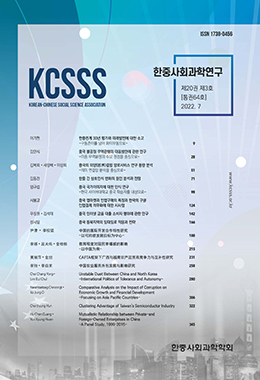广西地处中国西南边境, 与越南陆海交界, 是中国面向东盟的门户, 区位优势显著, 但经济相对落后。越南作为东盟新四国成员, 加入东盟时间相对较晚, 经济总量在东盟十国中处于中等水平。广西与越南在地域环境、生产技术、人口规模等方面都较为相似, 农产品贸易在双方的对外贸易中都具有举足轻重的地位。本文以中国―东盟自由贸易区(China-ASEAN Free Trade Area, CAFTA)作为研究背景, 基于2010―2020年广西与越南农产品贸易数据, 采用显示性比较优势指数(RCA)、出口相似性指数(ESI)、贸易互补性指数(TCI)对广西与越南农产品的竞争力与互补性进行实证分析, 探讨广西与越南农产品竞争力与互补性的变化趋势及特点, 在对CAFTA框架下广西与越南农产品贸易影响因素进行分析的基础上, 为提升双方农产品的国际竞争力、促进双边农产品贸易的可持续发展献计献策。研究发现: CAFTA对广西与越南的农产品双边贸易迅速发展起着积极的促进作用, 自2010年中国―东盟自由贸易区(CAFTA)建成以来, 广西与越南农产品贸易实现跨越式发展, 越南成为广西农产品贸易的第一大合作伙伴, 自2017年以来, 在广西农产品出口贸易中64%以上的农产品都是出口至越南, 进出口的农产品章类日益丰富。从RCA指数来看, 越南农产品的国际竞争优势要高于广西, 双方的植物产品在世界市场上具有较强竞争优势。广西与越南在世界市场的出口相似度低, 优势农产品各不相同, 竞争性较弱, 可以形成良好的互补关系。但仍存在一些消极因素, 制约了双边农产品贸易的和谐发展, 如双方贸易发展不均衡的问题, 越南长期处于贸易逆差地位, 广西与越南的农产品在国际竞争中的竞争优势都在逐年减弱, 农产品出口结构不合理, 附加值低, 政治、新冠疫情等非经济因素等。广西、越南可以通过对接 RCEP规则, 启动CAFTA3.0版建设, 积极参与区域内农产品的产业链、供应链、价值链的布局与重构, 改善农产品出口结构, 增加农产品的附加值, 提高农产品的国际竞争力, 大力引进涉农投资与技术, 加强沟通与协调, 妥善处理好南海问题等措施促进双方农产品贸易长期稳定发展。
Guangxi is located in the southwest region of China, bordering with Vietnam by land and sea, and is the gateway of China to ASEAN, with remarkable location advantages, but relatively backward economy. Vietnam, as a member of the new four ASEAN countries, joins ASEAN relatively late and its economic volume is in the middle level among the ten ASEAN countries. Guangxi and Vietnam are relatively similar in terms of geographical environment, production technology and population scale, and agricultural trade has a pivotal position in the foreign trade of both sides. This paper takes China-ASEAN Free Trade Area (CAFTA) as the research background, based on the agricultural trade data between Guangxi and Vietnam from 2010 to 2020,the competitiveness and complementarity of agricultural products between Guangxi and Vietnam are analyzed empirically by using the revealed comparative advantage index (RCA), the export similarity index (ESI) and the trade complementarity index (TCI),and the trend and characteristics of the competitiveness and complementarity of agricultural products between Guangxi and Vietnam are discussed. The study finds that: CAFTA plays a positive role in promoting the rapid development of bilateral trade in agricultural products between Guangxi and Vietnam, and since the completion of China-ASEAN Free Trade Area (CAFTA) in 2010, the trade in agricultural products between Guangxi and Vietnam has achieved leapfrog development, and Vietnam has become the first major partner of Guangxi’s agricultural products trade. Since 2017, more than 64% of agricultural products in Guangxi’s agricultural export trade have been exported to Vietnam, and the variety of agricultural products imported and exported is getting richer. From the RCA index, the international competitive advantage of Vietnam’s agricultural products is higher than that of Guangxi, and the plant products of both sides have a strong competitive advantage in the world market. The export similarity between Guangxi and Vietnam in the world market is low, the advantageous agricultural products are different, the competition is weak, and a good complementary relationship can be formed. However, there are still some negative factors that restrict the harmonious development of bilateral agricultural products trade, such as unbalanced trade between the two sides, Vietnam’s long-term trade deficit position, the competitive advantages of both Guangxi and Vietnam’s agricultural products in international competition are weakening year by year, unreasonable structure of agricultural products export, low added value, political, Covid-19 epidemic and other non-economic factors. Guangxi and Vietnam can promote the long-term and stable development of agricultural products trade between the two sides by docking RCEP rules, starting the construction of CAFTA version 3.0, actively participating in the layout and reconstruction of industrial chain, supply chain and value chain of agricultural products in the region, improving the export structure of agricultural products, increasing the added value of agricultural products, improving the international competitiveness of agricultural products, vigorously introducing agriculture-related investment and technology, strengthening communication and coordination, properly handling the South China Sea issue and other measures.




